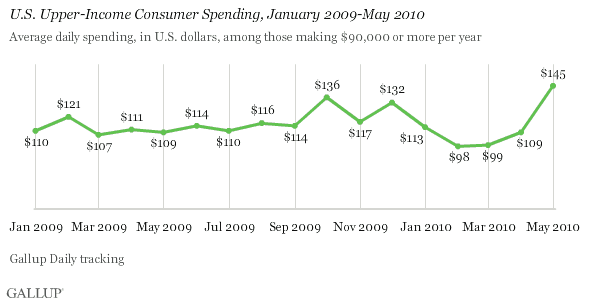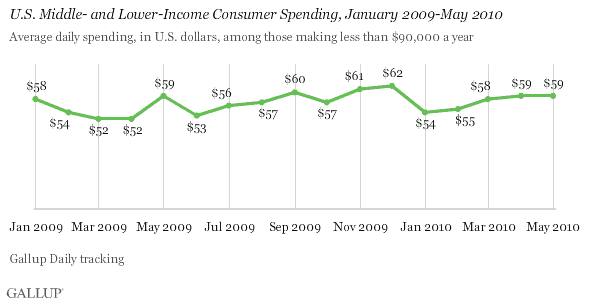PRINCETON, NJ -- Upper-income Americans' self-reported spending rose 33% to an average of $145 per day in May -- up from $109 per day in April 2010 and May 2009, and the highest monthly average since November 2008.

Upper-income spending in January 2010 was essentially the same as year-ago comparables, and below comparables in February and March. It again matched year-ago levels in April and has now far exceeded year-ago levels in May.
Middle- and Lower-Income Spending Unchanged
Middle- and lower-income Americans' self-reported spending averaged $59 per day in May, the same as in April 2010 and May 2009. Spending by these Americans has remained essentially the same over the past three months, but above March and April 2009 comparables.

Year-Over-Year Gains Across Gender, Age, and Region
Spending was up in May among both men and women. While it was also up across all age groups except 50- to 64-year-olds, it surged among those 65 and older. Spending was up in all regions except the South, where it was essentially unchanged.

Frugality Fatigue
Overall consumer spending increased 14% in May, driven entirely by the surge in upper-income spending. As a result, Gallup's May spending results seem consistent with reports from the lower- and middle-income retailers that consumer spending did not continue to improve last month. While spending was up overall in May, the flat spending numbers over the past three months among consumers earning less than $90,000 a year means weak sales for the retailers that serve them.
At the same time, May's spending illustrates that many upper-income consumers have the disposable income to increase their daily spending if they so desire. In a behavioral economics context, these consumers seemed to be holding back on spending prior to May in response to the length and depth of the recession, the financial crisis, and a general feeling of economic uncertainty.
In May, this seemed to change. It could be that many upper-income consumers are experiencing "frugality fatigue." That is, they are simply tired of cutting back and want to go back to spending -- maybe not as freely as they did prior to the recession, but at higher levels than they did last year, when frugality was commonplace. They may also be spending more freely because as recently as a month ago, many economic observers were talking about the financial crisis' being over and a sharp economic upturn taking place. Or, they may simply have decided that it is finally time to take a long-delayed vacation.
A sharp increase in upper-income Americans' spending is terrific news for the U.S. economy. These Americans generally have the wherewithal to spend, and when they do so, they generate consumer demand across the economy. In turn, this produces what the U.S. economy needs the most: a sharp and sustained increase in private sector jobs.
The question going forward is whether May's upper-income spending experience indicates a temporary spate of "frugality fatigue" or something more sustained. In this regard, the financial crisis in Europe and the resulting plunge in global equity markets may have a significant "wealth effect" impact on upper-income consumers -- and it, along with the uncertainties associated with the Gulf oil spill, may have already had an impact on economic confidence.
Regardless, Gallup's Daily consumer spending measure shows consumers continuing to spend in early June. If this continues, the idea of "frugality fatigue" is likely to garner increasing attention.
Gallup.com reports results from these indexes in daily, weekly, and monthly averages and in Gallup.com stories. Complete trend data are always available to view and export in the following charts:
Daily: Employment, Economic Confidence and Job Creation, Consumer Spending
Weekly: Employment, Economic Confidence, Job Creation, Consumer Spending
Read more about Gallup's economic measures
Survey Methods
Results are based on telephone interviews conducted as part of Gallup Daily tracking May 1-31, 2010, with a random sample of 14,303 adults, aged 18 and older, living in all 50 U.S. states and the District of Columbia, selected using random-digit-dial sampling.
For results based on the total sample of national adults, one can say with 95% confidence that the maximum margin of sampling error is ±1 percentage point.
Interviews are conducted with respondents on landline telephones and cellular phones, with interviews conducted in Spanish for respondents who are primarily Spanish-speaking. Each daily sample includes a minimum quota of 150 cell phone respondents and 850 landline respondents, with additional minimum quotas among landline respondents for gender within region. Landline respondents are chosen at random within each household on the basis of which member had the most recent birthday.
Samples are weighted by gender, age, race, Hispanic ethnicity, education, region, adults in the household, cell-phone-only status, cell-phone-mostly status, and phone lines. Demographic weighting targets are based on the March 2009 Current Population Survey figures for the aged 18 and older non-institutionalized population living in U.S. telephone households. All reported margins of sampling error include the computed design effects for weighting and sample design.
In addition to sampling error, question wording and practical difficulties in conducting surveys can introduce error or bias into the findings of public opinion polls.
For more details on Gallup's polling methodology, visit www.gallup.com.
